
Benvenuti! Welcome to Buona Domenica, a weekly newsletter of inspired Italian home cooking and baking. I’m a journalist, cooking instructor, occasional tour guide, and author of eight cookbooks on Italian cuisine.
This week’s recipe for Ragù alla Bolognese is for all subscribers, with a printable version available to paid subscribers. A companion recipe for Egg Tagliolini will go out to paid subscribers on Tuesday. Check out the entire Buona Domenica archive here, and the full index of recipes—202 and counting—here. All archived recipes are accessible to paid subscribers. If you are able to, please consider upgrading your subscription to support this newsletter. Grazie!
And if you enjoy reading this newsletter, please click at the little heart at the top of this post. This helps to bring visibility to Buona Domenica and our Italian food-loving community.
A couple of weeks ago, while I was still in Italy, I asked my daughter back home in Virginia what she would like me to make for her birthday dinner. After a really satisfying month of hosting tours and traveling for research, I didn’t want to leave. The thought of cooking a celebratory meal for Adriana made re-entry much more palatable.
She could have rolled her eyes and said she was going out with friends (she’s in her mid-20s), which of course would have been fine. But she answered right away, which made me think she had been pondering the question on her own, and this made me happy. It doesn’t matter how old they get, you never stop wanting to cook for your kids.
“I think I’d like Bolognese,” she said, meaning pasta with her nonna’s (my mom’s) rich meat ragù. It’s long been both my children’s favorite. It’s easy to make, but it takes time and requires patience. In other words, a good project when you’re moving about in a jet-lagged fog and just want to focus on one (delicious) task.
GABRIELLA’S BOLOGNESE
The first time I shared my mom’s recipe was back in 2008, in my book Big Night In. Even in a book that was filled with generous recipes (Double Carbonara, Fettuccine al Forno with Porcini, Shiitakes, and Truffles), it stood out for its opulence. Gabriella used a mix of ground beef, pork and veal and she browned the meat at length with finely chopped carrots, onion, and celery. She added a pinch of freshly grated nutmeg, and she enriched the ragù with broth, milk, and cream. As a final flourish, she stirred in finely chopped mortadella.
I’ve often wondered where her recipe came from. She started making it in the 1970s, possibly inspired by a family trip to Bologna, though I can’t say for sure. She grew up in Abruzzo, so it would not have been something she ate as a child; regional dishes did not travel as much in her day. An official recipe for ragù alla Bolognese was published in 1982 by the Accademia della Cucina Italiana. It calls for beef and fresh (not cured) pancetta, plus the vegetable foundation, wine, tomatoes, and an optional glass of milk. Permitted variations include using a mix of beef and pork and adding a pinch of nutmeg. Not permitted: veal, smoked pancetta, garlic or herbs, brandy in place of wine, and flour as a thickening agent. The recipe in Marcella Hazan’s Classic Italian Cookbook, which my mom had, is very similar to the official version, which makes sense, as she was from Emilia-Romagna.
I do see a touch of Pellegrino Artusi in my mom’s version. His recipe was published in 1891 in his seminal book La Scienza in Cucina e l’Arte di Mangiar Bene. Artusi’s recipe calls for veal and broth but no tomato. He also includes a pinch of nutmeg as an option, and suggests stirring in a little heavy cream at the end of cooking. I also see Ada Boni’s influence. Boni’s classic book Il Talismano della Felicita was my mom’s favorite cookbook—of that I have no doubt. The pages are stained, and filled with notes and colorful Post-It tabs marking recipes she had made or wanted to make. Boni’s ragù alla Bolognese uses beef or a mix of beef and pork or veal, plus broth, milk, a small amount of tomato, and crema di latte, which I take to mean the cream that floats to the top of the milk bottle.
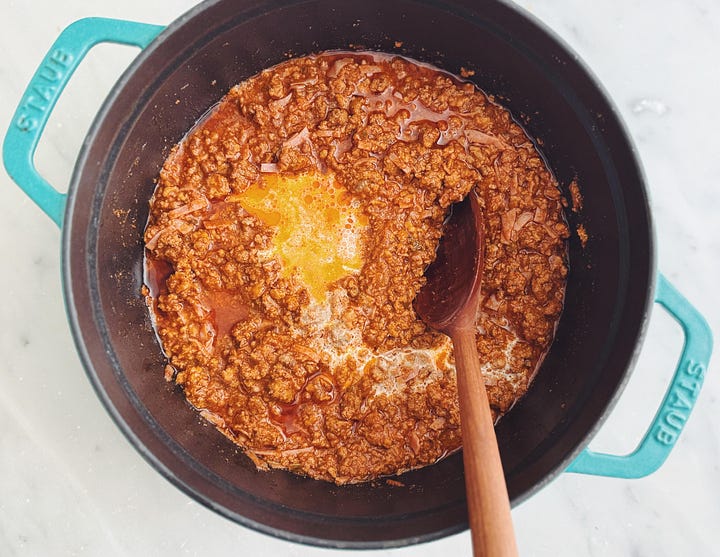
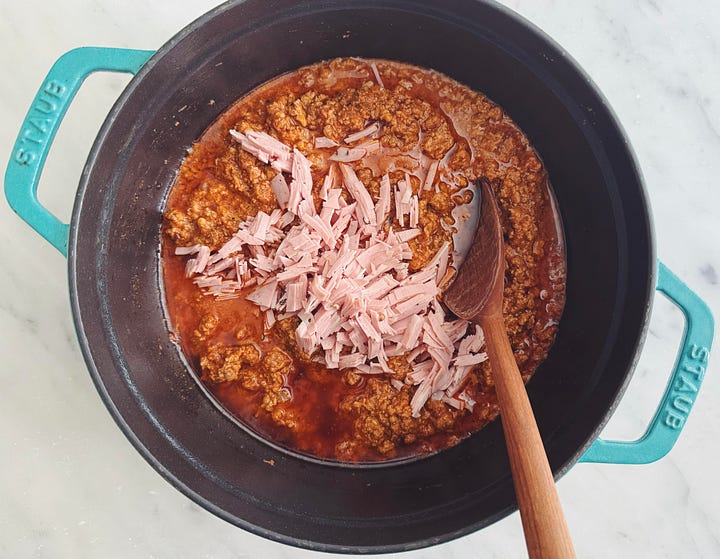
However, I’ve never seen another recipe that calls for Gabriella’s final, genius, touch: stirring in a fine julienne of mortadella, the creamy fat- and pistachio-studded cold cut from Bologna. (To call the fatty extravagance that is mortadella a cold cut somehow seems wrong and insulting but technically that’s what it is). For me, the gentle spice and silky texture that the mortadella contributes elevate this ragù above any other. (I am biased.)
Still, a few years ago, I decided to rework my mom’s recipe to make it slightly less opulent. As wonderful as it is, it’s a dated recipe. I took out the veal, which didn’t seem to add much, and a couple of other extraneous ingredients; and I reduced the amount of cream stirred in at the end to just a splash. This is the version I made for my daughter’s birthday. I’ve asked myself whether my mother’s recipe, or my adaptation, even qualify as “ragù alla Bolognese,” given their departure from the official version. I believe they do, as they are rooted in tradition and most of the changes (other than the mortadella) are considered acceptable variations. Also, if a recipe that includes powdered gelatin, half a pound of chicken livers, lamb shoulder, sage, bay leaves, and fish sauce can bill itself as a Bolognese ragù, then surely my mom’s and mine qualify.
More about ragù alla Bolognese: This ode in Roads & Kingdoms was published a decade ago, but it’s still an entertaining and informative read.
Where do you stand on Bolognese-style ragù? Are you a purist/traditionalist, or do you prefer improvisation?
THE NOODLES
For Adriana’s birthday, I had planned to make spinach tagliatelle, a classic pairing for Bolognese ragù. But after cooking down a bagful of spinach that I had bought at the farmers market, I was not happy with its muddy color, so instead I made simple egg noodles. In Emilia-Romagna, egg pasta is made with “00” (finely milled) soft-wheat flour. In Abruzzo, we tend to add semolina flour to our pasta dough, a more rustic take. I ended up using a mix of King Arthur all-purpose and semolina flour, which is what I had in my pantry. And I cut the noodles using my mom’s chitarra, so in the end it was an Emilia-Romagna-Abruzzo-USA mash up. I haven’t had time to write up the recipe yet, but I will do it tomorrow and send it out to paid subsribers on Tuesday. Make sure to upgrade subscription if you would like the recipe.
RECIPE: Ragù all Bolognese
This iconic ragù from Emilia-Romagna is all about meat. The small quantity of tomato in the sauce comes in the concentrated form of tomato purée and tomato paste, which add depth without turning it into a tomato sauce. You may be tempted to cut down on the browning time for the meat. Don’t give in. Slow, gentle browning is what gives this iconic ragù its deep flavor.
INGREDIENTS
2 tablespoons extra-virgin olive oil
2 tablespoons butter
1 medium onion, finely chopped
1 large carrot, finely chopped
1 rib celery, finely chopped, including any leaves attached
1 pound (454 g) ground beef
1 pound (454 g) ground pork
1 cup (240 g) dry white wine
1 teaspoon salt
Pinch of freshly grated nutmeg
1 cup (240 g) whole milk
1 cup (480 g) homemade Brodo di Carne or Vegetable Broth, plus more as needed; or best-quality store-bought beef or vegetable broth
2 tablespoons unseasoned tomato paste
1 cup tomato unseasoned passata (puree)
1/4 cup (60 g) heavy cream
2 ounces (57 g) mortadella, finely chopped
INSTRUCTIONS
1. Warm the butter and oil in a large Dutch oven or other heavy-bottomed pot over medium heat. Once the melted butter begins to sizzle, stir in the carrot, celery, and onion. Reduce the heat to medium-low and cook, stirring often, for 15 minutes, or until the vegetables are soft and golden.
2. Mix in the beef and pork and use a wooden spoon or spatula to break up the large pieces of meat. Cook over medium-low heat, stirring often, until the meat has turned a rich brown color and is crumbly but still tender. This will take longer than you think—about 1 hour. Over time, you will see the meat transform from a pink mass to an unappetizing gray, and, finally, a deep brown. It will be almost crumbly, but still juicy.
3. When the meat is ready, increase the heat to medium-high; add the wine and stir for a minute or two until it is absorbed. Return the heat to medium-low and season with the salt and nutmeg. Stir in the milk and cook gently until it has been mostly absorbed, about 3 minutes.
4. Dilute the tomato paste in the broth and add it to the pot. Stir in the tomato puree. Cover partially, reduce the heat to low, and let the sauce simmer ever so gently for 2 hours, until it is dense and brick colored and much of the moisture has been absorbed. Stir in the cream and mortadella, cover partially, and cook at a bare simmer for about 20 minutes, until the cream has been completely absorbed and the sauce is once again a rich brick color.
COOK’S NOTES
Good pasta choices: Egg or spinach tagliatelle; wide noodles such as pappardelle; lasagne; or for a more rustic application, noodles cut on a chitarra.
Make ahead: This sauce, like all ragùs, benefits from an overnight rest in the refrigerator. Let it cool to room temperature, then transfer it to a container with a tight-fitting lid. It can be refrigerated for up to 3 days or frozen for up to 3 months.
Click on the buton below for the printable version, available to paid subscribers.
YOU MAY ALSO LIKE…
Ragù Bianco
Think of this as a tomato-free version of Bolognese ragù: ground beef and pork, spiced with coriander, is browned, and then slowly simmered with wine and good (homemade) broth until you can almost stand a spoon in the pot. A splash of cream at the end takes it over the top, which is why this isn’t an everyday sauce
Thanks, as always, for reading, subscribing, and sharing.
Alla prossima,
Domenica




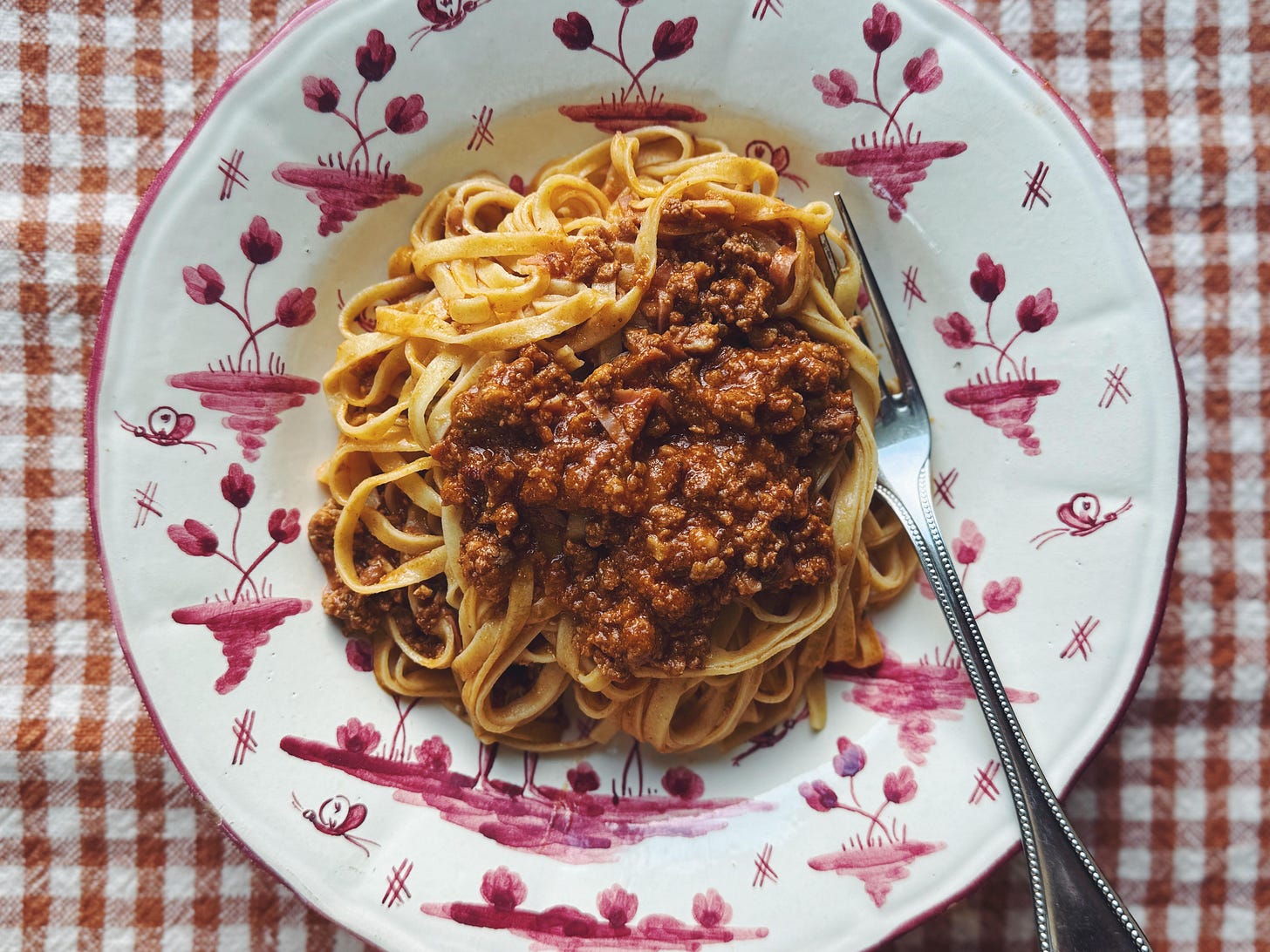
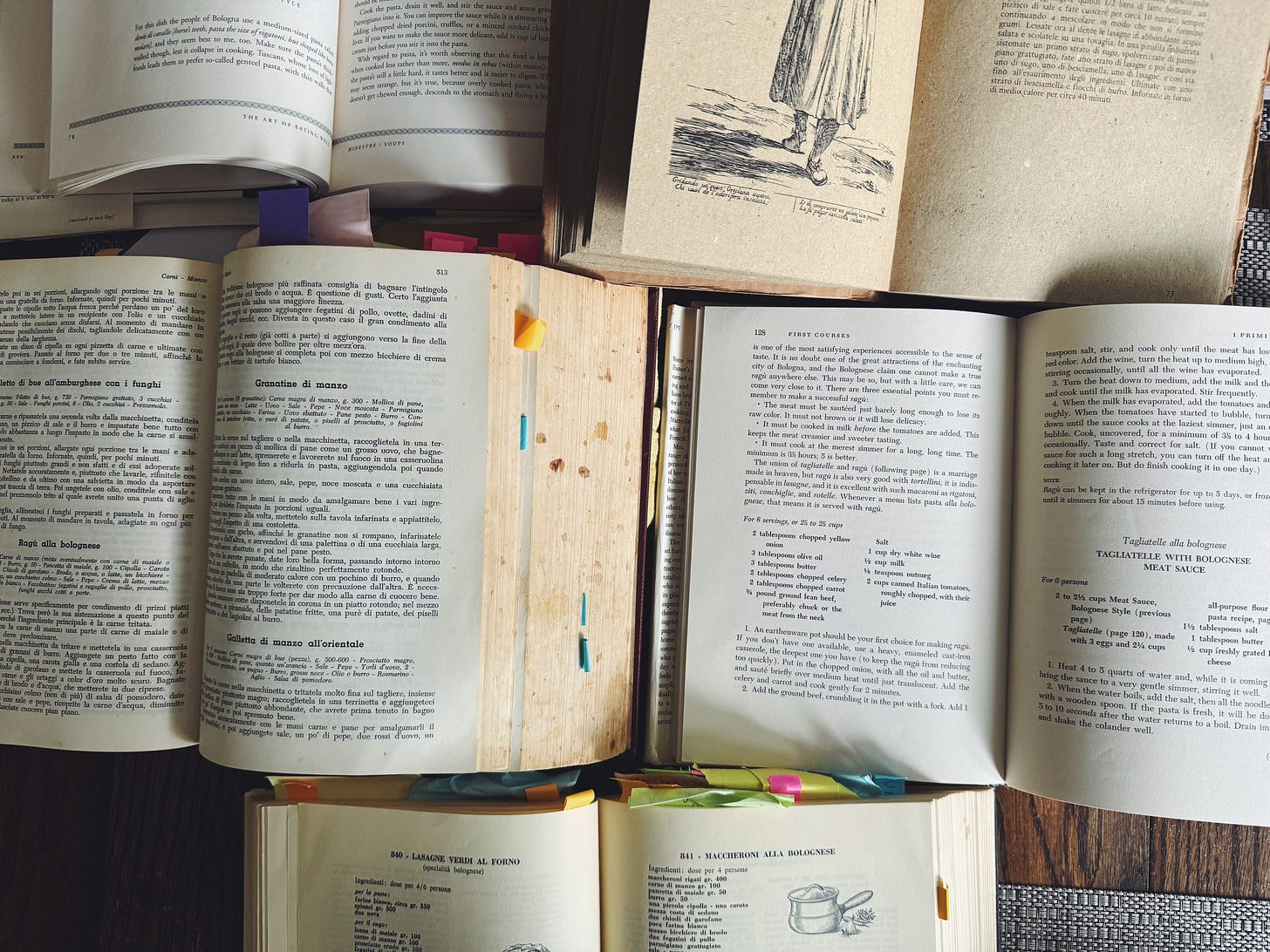
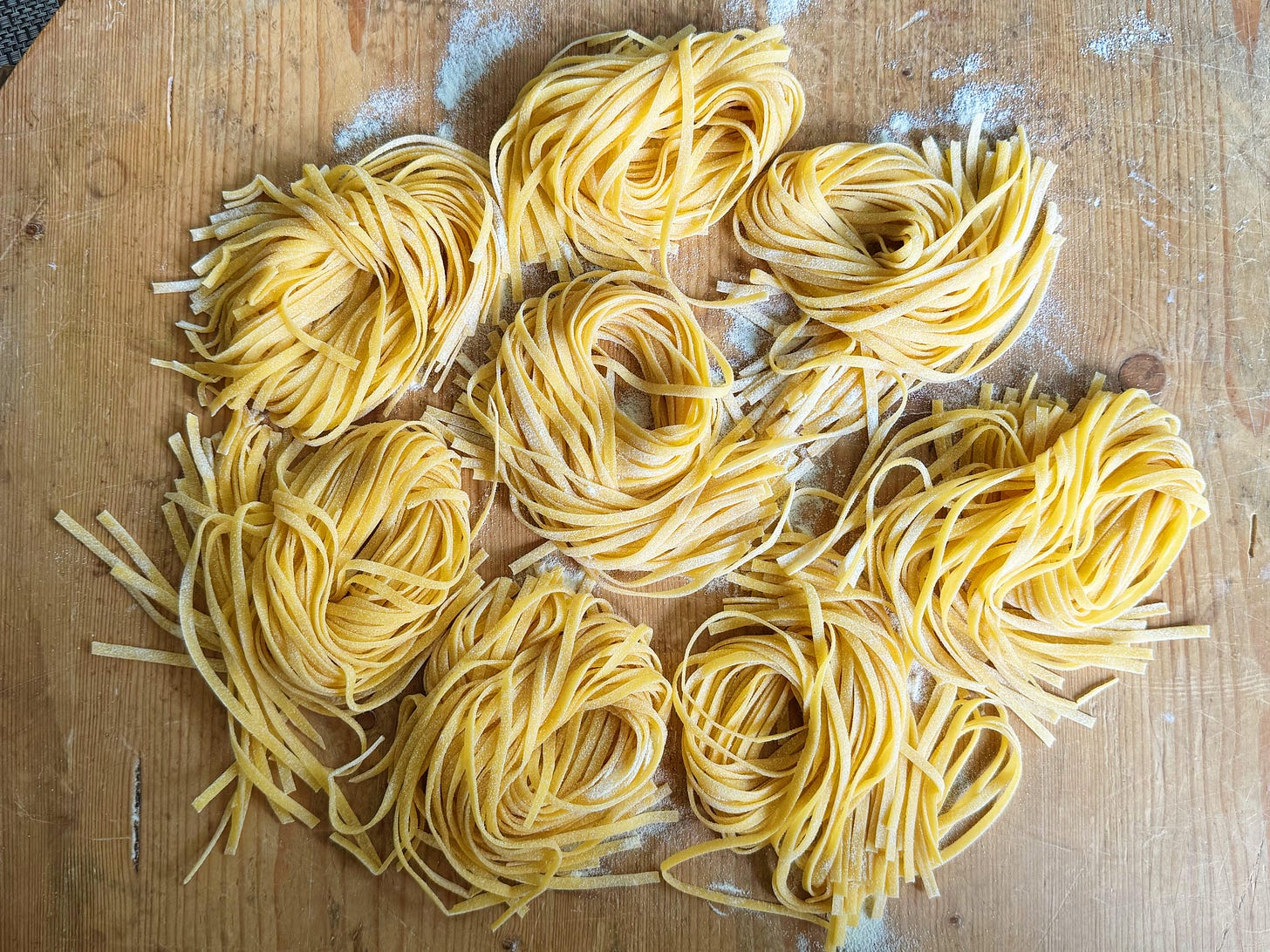
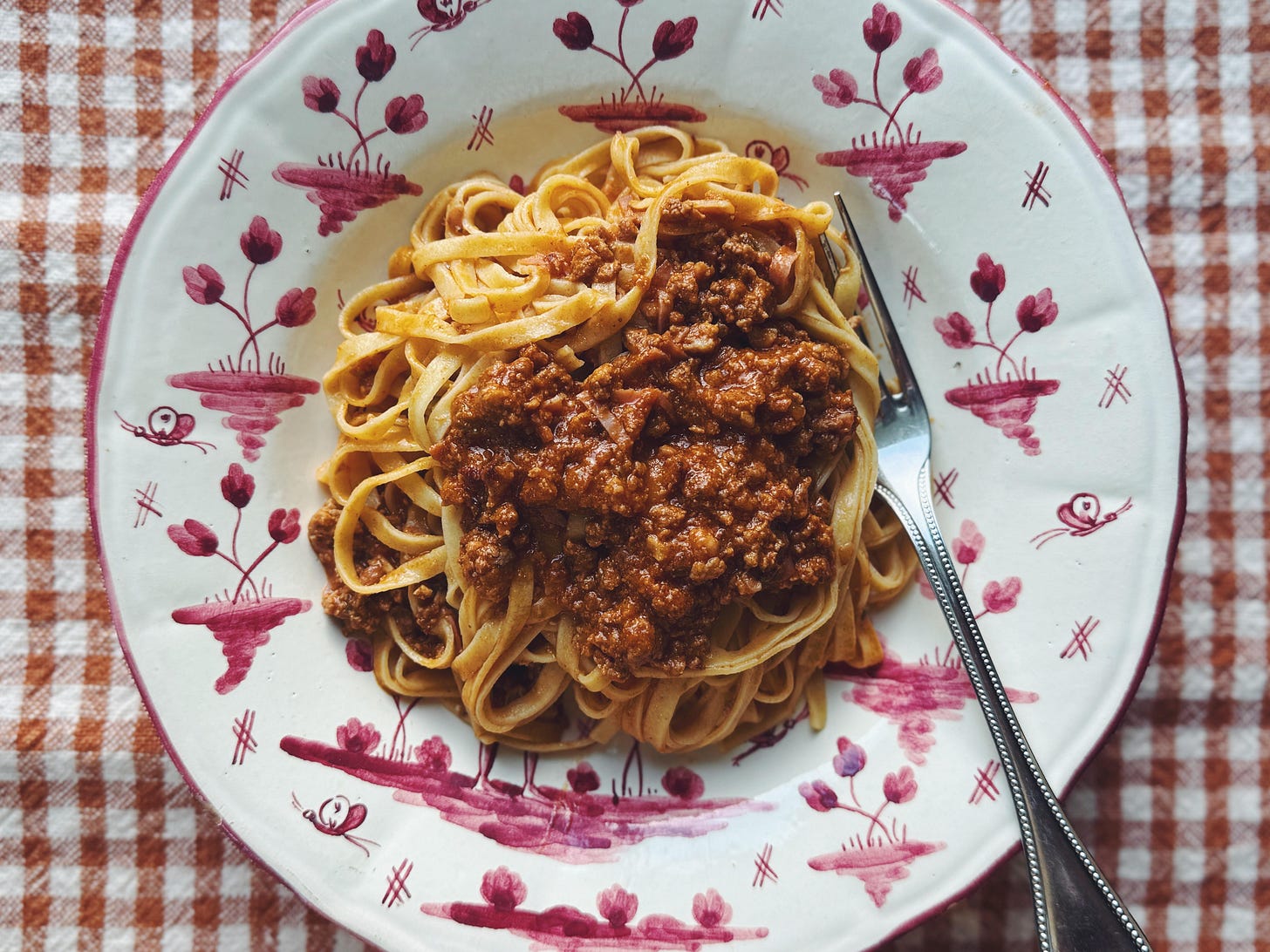
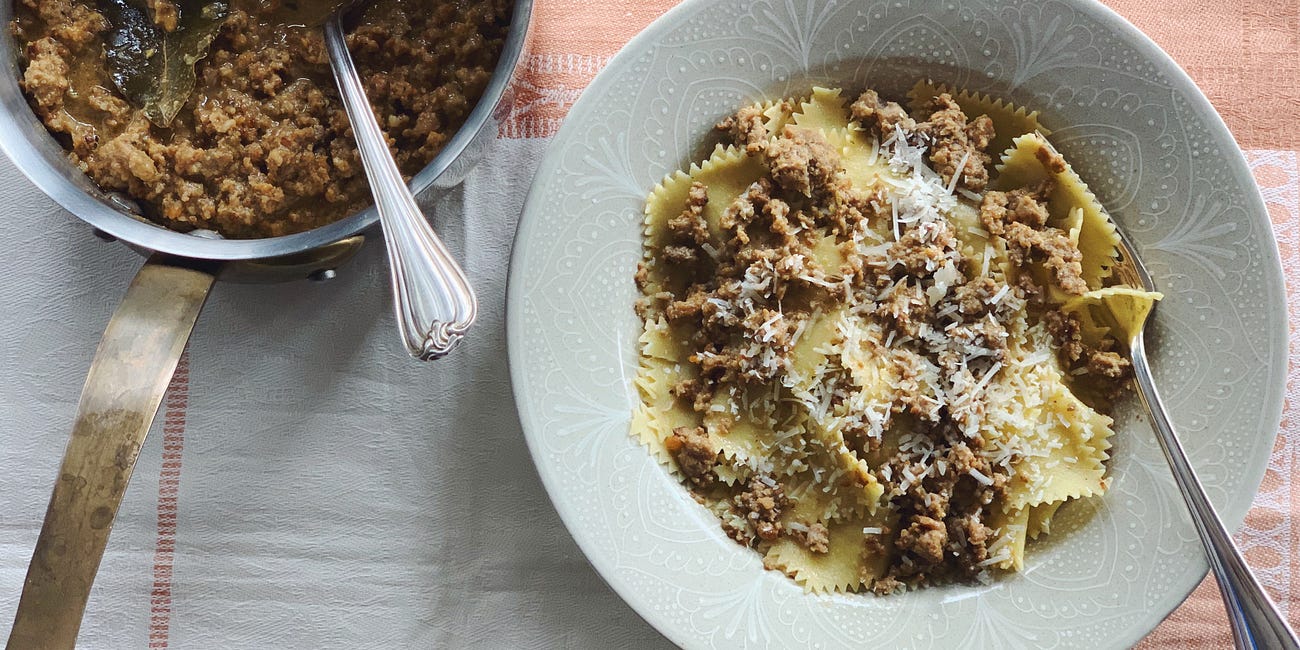
Why celebrate with cake when you can have this?
I don’t like when folks call “any old meat sauce” Bolognese. And usually it’s overwhelmed with tomato flavor.